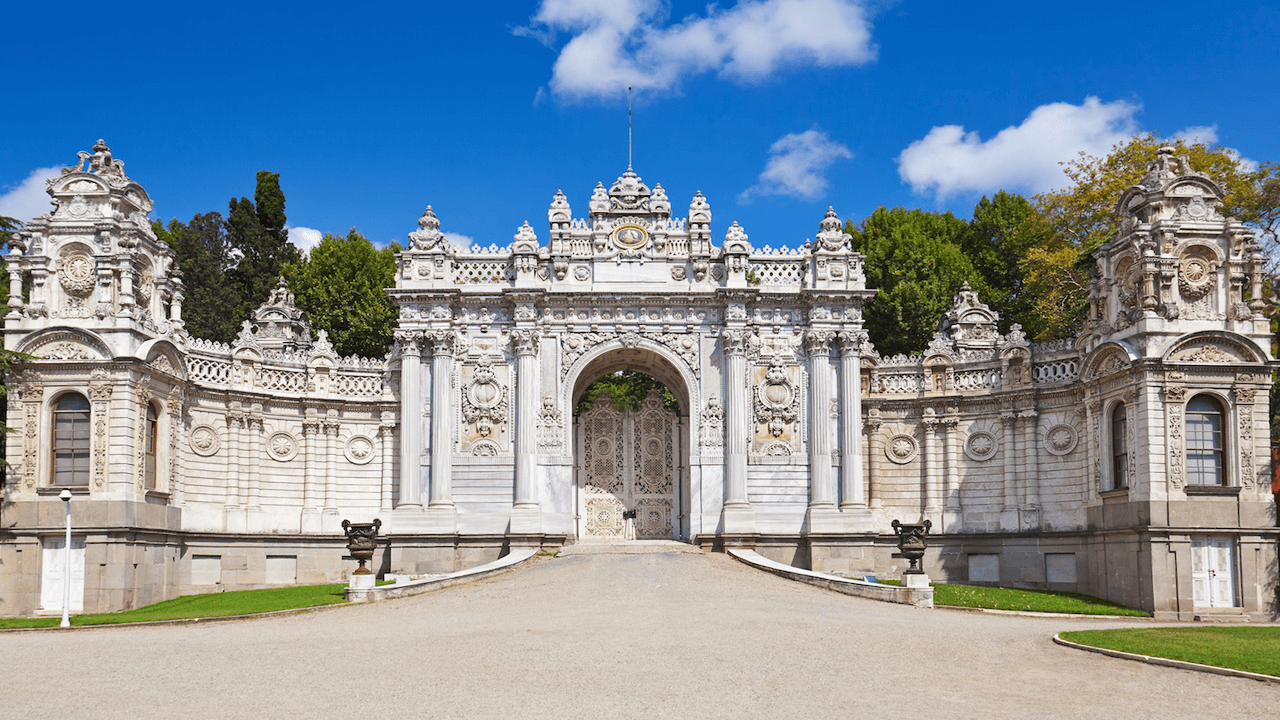Dolmabahçe Palace: Majestic Elegance on the Bosphorus
The Dolmabahçe Palace is one of Istanbul’s most impressive architectural gems. Built in the 19th century, this monumental building showcases the luxury and grandeur achieved during the twilight years of the Ottoman Empire. Combining Baroque, Rococo, Neoclassical, and traditional Ottoman styles, the palace proudly stands on the European shores of the Bosphorus in the Beşiktaş district. It served as the administrative center of the empire and the official residence of the sultans from 1856 until the abolition of the caliphate in 1924.
Spanning a total area of 15,000 square meters, the Dolmabahçe Palace boasts 285 rooms, 43 halls, 68 bathrooms, and 6 Turkish baths, making it the largest palace in Turkey. Replacing the historic Topkapi Palace as the seat of power, Dolmabahçe reflects the cultural and political transformation experienced by the empire in its final years.
History of Dolmabahçe Palace
The site where the Dolmabahçe Palace now stands was once a natural harbor known as “Dolma Bahçe” (filled garden), used by Ottoman fleets. Over time, the bay was filled and transformed into imperial gardens.
Sultan Abdülmecid I, inspired by European architectural trends of the era, commissioned the construction of the palace in 1843. The project took 13 years to complete and was finished in 1856, with the collaboration of prominent architects such as Garabet Balyan, Nigoğayos Balyan, and Evanis Kalfa. Dolmabahçe symbolized the empire’s attempt to modernize and align itself with European standards.
Although the palace was designed as a luxurious residence, it also served as a governmental hub. Later, during the Turkish Republic, the founder of the nation, Mustafa Kemal Atatürk, used the palace as his official residence in Istanbul. Atatürk passed away here on November 10, 1938, in one of the palace rooms, which has been preserved as a tribute to his memory.
Key Features and Attractions
Dolmabahçe Palace is divided into several sections, with the Selamlık and Harem being the main areas. The complex also includes the Clock Museum and the Crystal Pavilion, which are part of the guided tours.
Selamlık: The Administrative Section
The Selamlık houses the administrative quarters and state halls where ceremonies and receptions were held. Key highlights include:
- The Crystal Staircase: Crafted from Baccarat crystal, bronze, and mahogany, this staircase is one of the most striking features of the palace.
- The Throne Hall: This magnificent space spans 2,000 square meters, with a ceiling height of 36 meters and is adorned with 56 columns. At its center hangs the palace’s largest chandelier, made of Bohemian crystal and weighing 4.5 tons.
The Harem: The Sultan’s Private Quarters
The Harem, reserved for the sultan’s family, was an intimate and protected space. It housed the sultan’s mother, wives, concubines, children, and servants. While less ostentatious than the Selamlık, the Harem provides a fascinating glimpse into daily life at the palace.
Clock Museum and Crystal Pavilion
The Clock Museum features a unique collection of Ottoman and European clocks, while the Crystal Pavilion offers breathtaking views of the Bosphorus and serves as a relaxing spot within the complex.
Visitor Experience
Dolmabahçe Palace offers an unforgettable experience for history and architecture enthusiasts. Its blend of styles, opulent interiors, and rich history make it a must-see attraction in Istanbul. However, due to its popularity, it’s advisable to visit early to avoid crowds. Guided tours, while informative, can be somewhat restrictive, so allocate ample time to explore every corner of the palace.
Location
Dolmabahçe Caddesi, in Beşiktaş.
Visiting Hours
Tuesday to Sunday: 8:30 AM – 4:00 PM (until 3:00 PM in winter).
Closed on Mondays.
Admission
Adults: 40 TL
Students: 5 TL
How to Get There
Tram: Line T1, Kabataş stop.
Nearby Attractions
- Taksim Square (1.3 km)
- Galata Tower (2.7 km)
- Galata Bridge (3.2 km)
- Topkapi Palace (3.2 km)
- Gülhane Park (3.3 km)



3 thoughts on “Dolmabahce Palace”
★★★★★
Learning about and visiting ‘Dolmabahce Palace’ was both fun and educational. Everyone should experience this!
★★★★★
Visiting ‘Dolmabahce Palace’ was an extraordinary experience, offering insights and enjoyment like no other. Highly recommended!
★★★★★
My journey to ‘Dolmabahce Palace’ was nothing short of amazing. A must-see for anyone exploring the area!